An excited crowd gathered around Ting Wu’s Kaleidoscope exhibit, spilling out into the Hillside Campus hallways during ArtCenter’s Fall 2015 recruitment open house. Inspired by the toy she loved as a child, Wu wondered what it would be like to experience the inside of a kaleidoscope. Weeks of user testing and research for the Play Studio assignment paid off: The popular interactive installation transformed the joy of the single user toy into a shareable immersive and, yes, kaleidoscopically cool experience. Visitors hastily snapped selfies of their own digitized images while others used the installation to create stunning art. Perhaps most significantly, this unqualified Grad Show hit represented an important ArtCenter milestone: Its creator would soon become a member of the first class of ArtCenter students to earn a Bachelor of Science degree in Interaction Design, the College’s youngest undergraduate program.
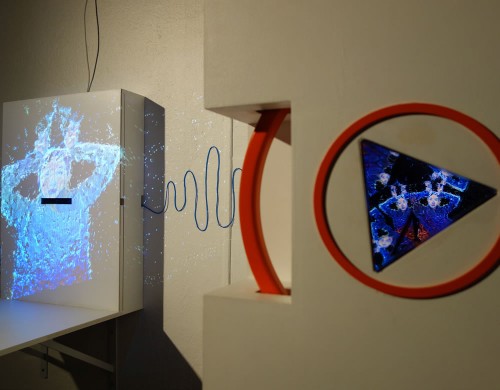
Ting Wu’s Kaleidoscope exhibit at ArtCenter’s recruitment event showcasing student work for Fortune 500 employers seeking new talent.
At the end of each term, scores of Fortune 500 recruiters swarm both campuses eagerly looking to hire the next generation of innovators. But for the first time in 85 years, attendees entered a studio showcasing Interaction Design.
More now than ever before, interaction design, also known as IxD, is undergoing unprecedented growth with demand for experienced designers increasing across all sectors of the economy. Business leaders are seeking talent equipped with the specialized skills to constantly improve the user experience—a key differentiator for any product or service in today’s hyper-competitive marketplace.
Asking the right questions and discerning between what we do and what we actually say—these are the fundamental skills of today’s interaction designers, who study how people think, feel and behave when they encounter a product, place or ecosystem.
Centered on improving lives, interaction design conceives and creates possible futures through new technologies. From autonomous transport to gesture-operated vision sharing systems, interaction design is vital for organizations as diverse as NASA, Tesla, BMW, Blizzard Games, Facebook, Google and many startups.
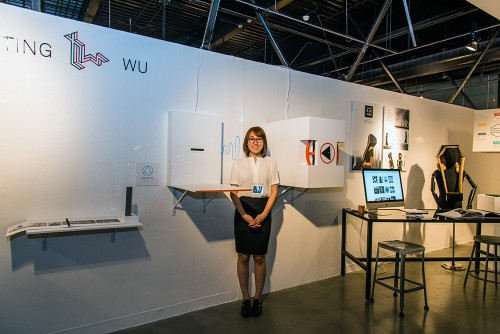
Co-creator of the Kaleidoscope interactive installation Ting Wu, a member of the first class of students to earn a Bachelor of Science degree in Interaction Design, the College’s youngest undergraduate program.
Ting Wu, 25, of Shenzhen, China together with Claudia Wang, 26, from a city near Shanghai and Karl Walker, 30, from the city of Olathe, Kansas, comprise the first class of IxD graduates from ArtCenter. Throughout this unique program, under the leadership of veteran interaction designer and department chair Maggie Hendrie, this inaugural cohort has participated in multiple trans-disciplinary classes, developed impressive graphic and media design skills as well as the latest coding and physical prototyping abilities.
A project sponsored by Dell offered a range of challenges for the IxD experts. Wang developed an interactive product aimed to help a patient diagnosed with diabetes achieve a healthier lifestyle, while Walker, for the same class, created a solution to help commercial airline flight attendants communicate more effectively and improve safety procedures.
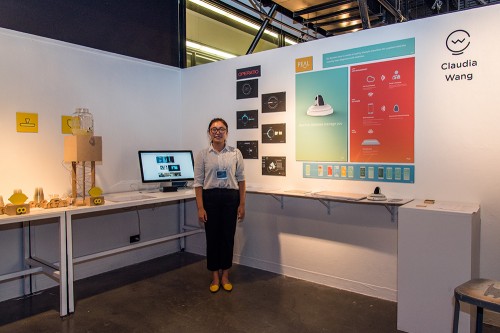
During an internship with BMW Group DesignWorksUSA, Claudia Wang worked on the Rolls-Royce Phantom interface design.
Understanding play is big business. The U.S. toy industry has an annual U.S. economic impact of $76.71 billion, according to the Toy Industry Association, an organization devoted to “sharing the genius of play.” Wu’s kaleidoscope project emerged out of an assignment to develop innovations in play. As part of her research, Wu made some unexpected discoveries while experimenting with tilting video projection and Z Vector Touch software that connects with an Intel RealSense 3D camera in a black box to create sound reactive effects. “I made the kaleidoscopes big enough so that users didn’t need to close an eye to see what is inside,” she explains, referring to a screen her kaleidoscope connected to a 3D camera. “When people realized the relationship between what they see in the kaleidoscope and what the camera is capturing, they interact and play with each other through Kaleidoscope.”
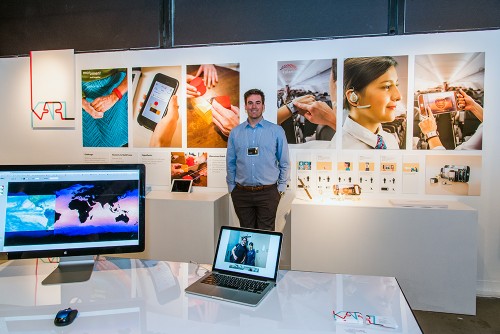
Olathe, Kansas native Karl Walker interned at NASA’s Jet Propulsion Laboratory while completing his degree in Interaction Design at ArtCenter.
We recently sat down with the first class of graduates from the Interaction Design department to learn about their journeys—individually and collectively. Though all the students in this first class share a curiosity about the relationship between human behavior, design and technology, they come from wildly different backgrounds. Originally a fine art major, Wu “didn’t know anything about interaction design” until she sought out friends who study computer science who clued her in to the thriving field. Wang, who possessed a previous bachelor’s degree in engineering and industrial design, heard ArtCenter was offering a new program while in Beijing where she worked on the information architecture for the prison management system of Miyun Court. And Walker, an Eagle Scout and experienced lifeguard who transferred to IxD from ArtCenter’s Transportation Design department, said he was most drawn to the idea of developing empathy for the user and that convinced him to sign up. “In the beginning, I didn’t understand that interaction design was so prevalent in so many areas,” he said. “I started to learn about ecosystems and how different systems support everybody every day.”
What has it been like for you to be in this field where things are evolving so quickly?
Wu: The fact that the field is constantly evolving is what attracted me to interaction design. I feel like the skills we learn at ArtCenter really apply to many different fields. From web and mobile apps to game design, autonomous cars and smart products — everything digital that you can interact with. That’s how I keep myself relevant.
When you explain the field of interaction design, how do you simplify it for people?
Walker: There are a lot of different ways that we interact with systems. Every move of a Wii bowling match was researched and developed by a designer. Users helped determine the most intuitive way that you would try to make that move with the stick. A more well‑known use of IxD is digital systems such as apps, websites and digital interfaces.
Wang: Before I came to ArtCenter, I took an interaction design class. They basically just designed the user interface for apps and websites. But, like Karl said, at ArtCenter, they teach us to see the system from a higher level. You understand and design the whole ecosystem.
What are the unexpected discoveries you’ve made about professional opportunities or career paths you may pursue?
Wang: At first, I was thinking about maybe going to Facebook or Apple. But recently I discovered the niche of designing systems for the employees of those types of large companies. Creating a company system for stakeholders is an opportunity I haven’t thought about before, for example, how to help employees work more efficiently.
Wu: During this year, I feel like the way I look at things has changed. So, I can see things from the user’s point of view and different perspectives which I think really helps me a lot.
Is there one project that defined your time here, or was the most significant?
Wang: The most challenging class for me involved dealing with actual clients. Sponsored Projects gave me valuable professional training to propel my career.
Walker: My internship at NASA’s Jet Propulsion Laboratory (JPL) provided me with significant work experience while I worked on interactive data visualization and application design. It was a unique opportunity because my mentor gave us free rein to find a project we wanted to work on instead of assigning us a project. He would give us feedback once a week, but we were really in charge of driving the project. That was a big growing experience for me because I had to go back and call on my knowledge without guidance from a teacher. I had to figure out the process and how to steer it myself and inform my colleagues about my progress.
Then, my independent study project with ArtCenter faculty member J.G. Buckley helped me build on that experience. It was significant because I chose to work on more extreme user cases. I developed a project to improve the quality of life for Alzheimer’s patients inspired after my Grandmother was diagnosed with the disease. (See Walker’s Alzheimer’s project featured on the popular professional design destination CORE77.)
Walker: During my internship with Life Technologies, a biotech company in Carlsbad, I was able to build on the foundational skills I gained from my work in transportation design. At JPL, I worked on a web app for scientists — a public facing site that helps scientists make qualitative analysis on data, so that they can understand relationships between different data sets.
Wang: I interned at BMW Group DesignWorksUSA. My tasks were to design the Rolls-Royce Phantom interface and the concept development of the new i3 interface. It was a really valuable experience for me to work with professionals.
Wu: During my internship at a startup company in Shenzhen, I participated in new product development and user research. We tried to make wearable devices more fun and engaging for users. I learned a lot about the wearable devices market in China.
As an intern at Chrysler, I developed a tablet to be used by passengers inside the car. I focused on the JEEP off‑roading experience because it’s something I’m interested in. My goal was to make the ride more fun for passengers. One tablet feature utilized augmented reality to create location-based customized 3D avatars along the route to simulate a scavenger hunt. It would also be helpful to connect several cars traveling in a caravan to allow interaction among each vehicle.
What would you say are some of the most valuable skills you’ve gained ?
Wu: Learning the interaction design process is extremely valuable and knowing how to make design decisions based on my understanding and knowledge of my users through research and testing.
Walker: I’d say some of the most valuable tools are prototyping from low fidelity, which would be sketches, up through high fidelity such as making digital mockups. Our process involved printing out sketches, cutting them up to create mockups so that you can essentially make a paper interface. And then one of the essential rules is testing that interface with users.
Wu: One of my projects is a wearable sofa (featured on CORE77). It has a sensor at the back of the neck. So, when people lean back, try to relax, you hear soothing sounds of nature.
What inspired that idea?
Wu: The back story is set in an industrial city with poor living conditions. Residents are stressed. They are alive, but not living. We call it R.I.P. So, my teammate and I came up with the sofa in the shape of a coffin. Our goal was to create a sense of relaxation and peace of mind. When we studied how people relax, we figured out the movement of leaning back. We decided to use the back of the neck as the site for the wearable.
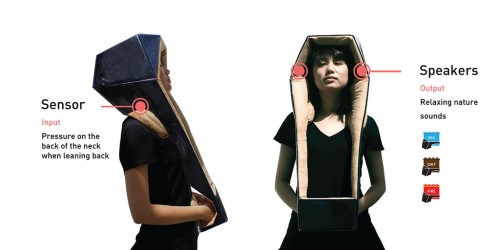
Ting Wu’s R.I.P. wearable sofa is designed to provide peace and tranquility for rebellious young residents of an industrial city.
What advice do you have for others who might be considering a degree in interaction design?
Walker: They should work on their sketching and communication skills through visuals because a lot of what you come up with is stuff that you think of, but you need to tell somebody about it somehow. Sketching is often the first way to do that. I found out just how important it was during my internship. It was the best way to communicate with my peers.
Wang: For me, I think the most important skill is functional prototyping because it is the most efficient way to show clients my ideas. Prototyping combined with a Keynote presentation gives clients a clearer understanding of what I’m proposing.
Wu: I would tell them to go for it if they’re interested in designing the digital world, and having a say about how we live in the digital world. Imagine how much time is spent in that world everyday. The skills you learn at ArtCenter will help build a better digital world.
For more information, visit Interaction Design at ArtCenter.








